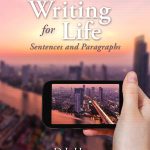Writing for Life
$186.65
| Title | Range | Discount |
|---|---|---|
| Trade Discount | 5 + | 25% |
- Description
- Additional information
Description
More Grammar Exercises
- In response to reviewer requests, our grammar exercises have been expanded to offer more problems per exercise — providing students with the practice they need to master each skill. The exercises for punctuation and mechanics now appear in MyWritingLab for easy student access and completion.
- The grammar chapters have been reorganized to move students from basic sentence-level concerns to issues of style. This new, more natural progression makes content both easier to find and easier to assign in sequence.
New Readings
- Eight new readings have been added to Part 7, including “Getting Coffee Is Hard to Do” by Stanley Fish, “An American Slave: Written by Himself” by Frederick Douglass, “Gen X is Far From Mars, Gen Y Is Far From Venus: A Primer on How to Motivate A Millennial” By Rob Asghar, “All About Jazz, Uniquely American Music” by Moira E. McLaughlin, “Why War Is Never A Good Idea” by Alice Walker, “Lifetime Effects of Stress and What Causes It” by Rebecca J. Donatelle, “It’s Time to Ban High School Football” by Ken Reed, and “The Benefits of Playing Sports Aren’t Just Physical!” by the American Orthopaedic Society for Sports Medicine.
- Three student writers contributed paragraphs to illustrate the patterns of organization.
New Supporting Media and Deeper MyWritingLab Integration
- New videos on the writing process, the reading process, and creating portfolios help students with different learning styles understand these key concepts.
- Our two chapter-closing activities, “Writing Assignments” and “Academic Learning Logs,” can now be completed in MyWritingLab and sent directly to instructors’ gradebooks.
- The Writing for Life MyWritingLab eText course now contains an appendix on portfolio creation and use.
Streamlined Approach to Learning Outcomes
- The learning outcomes now appear on the first page of every chapter and tie directly to the headings in the chapter. These learning outcomes help students focus on the key skills that they will develop in the chapter, and provide them with a measure to test their mastery.
- Unit Review exercises enable students to test their mastery of each learning outcome in that Unit. These Unit Review exercises are available in MyWritingLab.
Modified Design
- Writing for Life’s revolutionary design has been tweaked to appear more sophisticated where appropriate and easier to digest at a glance.
Also available with MyWritingLab™
MyWritingLab is an online homework, tutorial, and assessment program designed to work with this text to engage students and improve results. Within its structured environment, students practice what they learn, test their understanding, and pursue a personalized study plan that helps them better absorb course material and understand difficult concepts. In addition to the full eText, activities directly from the text are available within MyWritingLab. These include the written assignments, readings from the text, review exercises and more.
For courses in Developmental Writing — Sentence & Paragraph.
Shows students “What’s the point?” of improving writing skills
Writing for Life: Sentences and Paragraphs is part of a two-book series that helps students understand the importance of strong writing skills and motivates them to become better writers. Students are encouraged to take charge of their own learning, and to transfer the strategies they currently apply to reading visuals to reading and writing text. The Third Edition offers high-interest topics, meaningful visuals, clear learning objectives, a wealth of examples, and ample opportunities for students to practice applying new concepts to their own writing skills.
Also available with MyWritingLab™
MyWritingLab is an online homework, tutorial, and assessment program designed to work with this text to engage students and improve results. Within its structured environment, students practice what they learn, test their understanding, and pursue a personalized study plan that helps them better absorb course material and understand difficult concepts. In addition to the full eText, activities directly from the text are available within MyWritingLab. These include the written assignments, readings from the text, review exercises and more.
Students, if interested in purchasing this title with MyWritingLab, ask your instructor for the correct package ISBN and Course ID. Instructors, contact your Pearson representative for more information.
Acclaimed textbook author D.J. Henry is a veteran teacher with over 25 years of community college experience and is a former developmental education student herself.
Over the course of her teaching career, she has served on several federally funded grants designed to infuse teaching and learning with sound pedagogies and technological support. Her extensive experience in the standardized testing of literacy competencies includes working with the State of Florida from 1982 to 2002 as an item writer, rubric writer, and reader for the College Level Academic Skills Test (CLAST) and the State Developmental Reading and Writing Exit Exam. For more than 15 years, she served as a reader for the Florida Teacher Certification Exam (FTCE). In addition, her expertise has led her to work with the Southern Association of Colleges and Schools (SACS) as a Lead Evaluator for the Quality Enhancement Plans of several colleges and as a co-presenter of workshops on assessment at SACS’ annual conferences in 2006, 2007 and 2008.
A passionate educator and dedicated colleague, Henry continues to share her expertise in reading, writing and authentic assessment through numerous presentations and workshops at national, regional and local conferences and at individual colleges.
Have a question or comment to share with D.J. Henry? Please email her. She would love to hear from you!
For courses in Writing.
Shows students “What’s the point?” of improving writing skills
Writing for Life: Sentences and Paragraphs is part of a two-book series that helps students understand the importance of strong writing skills and motivates them to become better writers. Students are encouraged to take charge of their own learning, and to transfer the strategies they currently apply to reading visuals to reading and writing text. The Third Edition offers high-interest topics, meaningful visuals, clear learning objectives, a wealth of examples, and ample opportunities for students to exercise their own writing skills.
Also available with MyWritingLab™
MyWritingLab is an online homework, tutorial, and assessment program designed to work with this text to engage students and improve results. Within its structured environment, students practice what they learn, test their understanding, and pursue a personalized study plan that helps them better absorb course material and understand difficult concepts. In addition to the full eText, activities directly from the text are available within MyWritingLab. These include the written assignments, readings from the text, review exercises and more.
Note: You are purchasing a standalone product; MyWritingLab does not come packaged with this content. Students, if interested in purchasing this title with MyWritingLab, ask your instructor for the correct package ISBN and Course ID. Instructors, contact your Pearson representative for more information.
If you would like to purchase both the physical text and MyWritingLab, search for:
0134120884 / 9780134120881 Writing for Life: Sentences and Paragraphs Plus MyWritingLab with Pearson eText – Access Card Package
Package consists of:
- 0133944131 / 9780133944136 MyWritingLab with Pearson eText – Access Card
- 013394414X / 9780133944143 MyWritingLab with Pearson eText – Inside Star Sticker
- 0134021703 / 9780134021706 Writing for Life: Sentences and Paragraphs
I. GETTING READY TO WRITE
1. Preparing to Learn about Writing
II. THE BASIC SENTENCE
2. Nouns and Pronouns
3. Adjectives and Adverbs
4. Verbs
5. Subjects, Verbs, and Simple Sentences
6. Compound and Complex Sentences
III. EDITING THE BASIC SENTENCE
7. Run-ons: Comma Splices and Fused Sentences
8 Fragments
9. Misplaced and Dangling Modifiers
10. Subject-Verb Agreement: Present Tense
IV. PUNCTUATION AND MECHANICS
11. The Comma
12. The Apostrophe
13 Quotation Marks
14. End Punctuation: Period, Question Mark, and Exclamation Point
15. Capitalization
16. Improving Your Spelling
17. Mastering Often-Confused Words
V. WRITING PARAGRAPHS
18. Thinking through the Writing Process
19. Understanding the Paragraph
20. Using the Patterns of Organization to Develop Your Paragraphs
VI. REVISING TO IMPROVE EXPRESSION
21. Sentence Variety
22. Sentence Clarity: Person Point of View, Number, and Tense
23. Dialects and Standard English
24. Revising for Effective Expression
VII. READING SELECTIONS
Appendix
Writing an Essay
Focus on Writing Process
- Chapter 1: Preparing Yourself to Learn About Writing helps students jump into the course by instructing them to evaluate their attitudes, identify learning outcomes, generate a study plan, and create a portfolio that helps them track their growth, organize their work, and think about their writing.
- Emphasis on the Process is embedded in instruction throughout the book. The writing process is discussed in Chapter 2 with a full-color graphic, and appropriate writing process icons appear throughout the book to guide students through particular assignments.
- The Writing Situation is explained and illustrated in Chapter 2 and teaches students how the relationships among topic, audience, and purpose impact the creation of a piece of writing.
- Text Structure is covered extensively at every level, including word, sentence, paragraph, and essay.
Ample opportunities for students to apply new concepts in their own writing
- UPDATED! Grammar Exercises have been expanded to give students more opportunities to practice their skills in this area. The exercises for punctuation and mechanics now appear in MyWritingLab.
- Writing Assignments create realistic writing situations that instruct students to consider their audience and purpose. Topics and situations are relevant to “Everyday Life”, “College Life”, and “Working Life.”
- Workshop: Writing a Paragraph Step-by-Step guides students through the writing process one step at a time from prewriting to editing. Each phase is highlighted with a writing process icon to ensure students are fully aware of their progress.
Focus on metacognition
- What’s the Point? is a motivational teaching strategy that addresses the question why do I need to know this? that often crosses students’ minds to establish a purpose for each chapter. Sample student responses in think-aloud format model critical thinking.
- Self-Assessment Tools and Guides include learning outcomes, reflective questions, behavior and attitude surveys, guidelines, checklists, scoring rubrics, and journal entries, complete with examples and explanations. For example, a paragraph scoring guide is introduced and explained and followed by a practice that asks students to score a set of paragraphs using the scoring guide. These activities transfer the responsibility of learning and assessment of learning to the student.
- Chapter 1, Preparing Yourself to Learn About Writing, teaches students to evaluate their attitudes, identify learning outcomes, generate a study plan, and create a portfolio that helps them “to track growth, organize work, and think about” their learning and their writing. Simple and easy-to follow advice guides students to use checklists, reflective questions, and journal entries as they think about their writing and what they are learning.
Pedagogy that resonates and motivates
- Overall Instructional Voice establishes a clear, direct, respectful tone that honors adult learners.
- Emphasis on Active Learning motivates students to assume responsibility for their own learning, reflect upon their progress, and work to improve their own writing skills.
- UPDATED! Student motivation has been applied to grammar lessons, a subject students often dread.
- Grammatical Concepts are comprehensively covered in an approach that combines an illustrated handbook with intensive practice. Examples are clearly annotated visuals with color-coded highlights.
- Grammar in Action directly addresses some of the most common grammar errors students make in the context of a particular pattern of organization.
- UPDATED! Learning Outcomes now appear on the first page of every chapter and tie directly into chapter headings. Learning Outcomes help students focus on the key skills they will develop in that chapter and provide them with a measure to test their mastery.
- Self-Assessment Tools and Guides include learning outcomes, reflective questions, behavior and attitude surveys, guidelines, checklists, scoring rubrics, and journal entries, complete with examples and explanations.
High interest examples/readings
- High-Interest Topics such as tattoos, stress, obesity, eating disorders, pop culture icons, fashion, movies, music, relationships, natural disasters, heroes, and current events engage student interest and foster self-expression.
- NEW! Three student writers contributed to paragraphs to illustrate the patterns of organization.
- Direct Instruction helps each lesson move systematically through three distinct phases–before, during, and after learning activities–to ensure student comprehension.
- REVISED! The Grammar Chapters have been reorganized to move students from basic sentence-level concerns to issues of style. This progression is more natural and makes the content both easier to find and assign in sequence.
- Academic Learning Logs are end-of-chapter activities that test students’ comprehension of chapter topics.
- NEW! Seven readings have been added to Part 8, including:
- “Niagara Falls” by Rupert Brooke
- “Managing Stress in College” by Rebecca J. Donatelle
- “The Fundamentals of Forgiveness” by D.J. Henry
- “Cool at 13, Adrift at 23” by Jan Hoffman
- “Nobel Peace Prize Lecture, 2014” by Malala Yousafazai
- “Hungry cs. Healthy: The School Lunch Controversy” by Bonnie Taub-Dix
- “Can Virtual Classroom Beat Face-to-Face Interaction?” by Libbie Page
Emphasis on visual learning
- UPDATED! Modified design makes the book more sophisticated where appropriate and easier to digest at a glance.
- High-Interest Visuals clarify concepts and facilitate student responses. Several images are brought to life with animations accessible through MyWritingLab.
- Photographic Organizers activate the thinking process, introduce and illustrate a pattern of organization, and stimulate prewriting activities. Photographs are arranged in a concept map that illustrate particular patterns of organization.
- Visual Learning Activities introduce and facilitate writing assignments, while concept maps, charts, graphs, and annotated examples enable students to “see” the concept clearly.
- Visual Instruction offers annotated visuals with colored highlights to make concepts jump off of the page as they are further defined, explained, and illustrated with charts and graphs.
Also available with MyWritingLab™
MyWritingLab is an online homework, tutorial, and assessment program designed to work with this text to engage students and improve results. Within its structured environment, students practice what they learn, test their understanding, and pursue a personalized study plan that helps them better absorb course material and understand difficult concepts. In addition to the full eText, activities directly from the text are available within MyWritingLab. These include the written assignments, readings from the text, review exercises and more.
Additional information
| Dimensions | 1.35 × 8.55 × 10.85 in |
|---|---|
| Imprint | |
| Format | |
| ISBN-13 | |
| ISBN-10 | |
| Author | |
| Subjects | higher education, Language Arts / Literacy, Developmental English, Developmental Writing |




